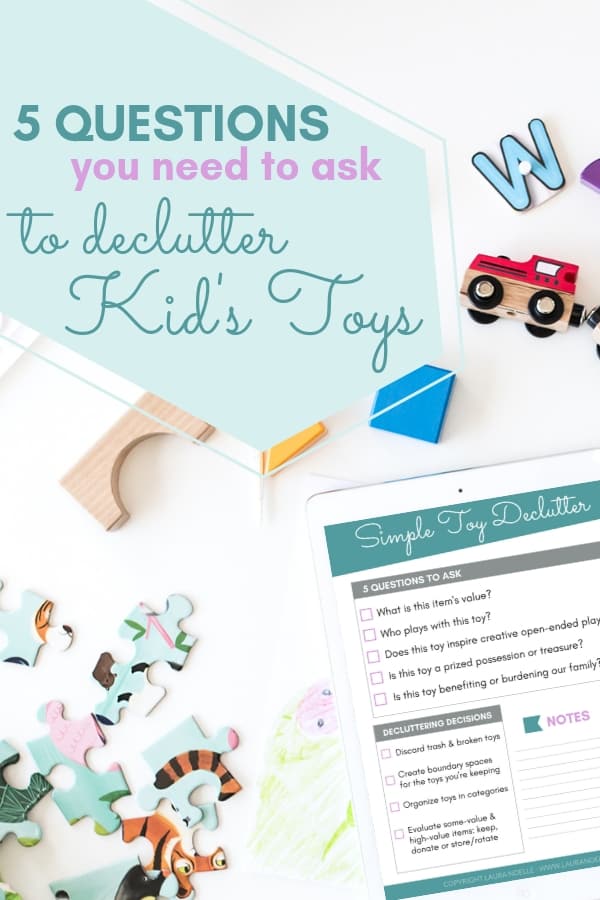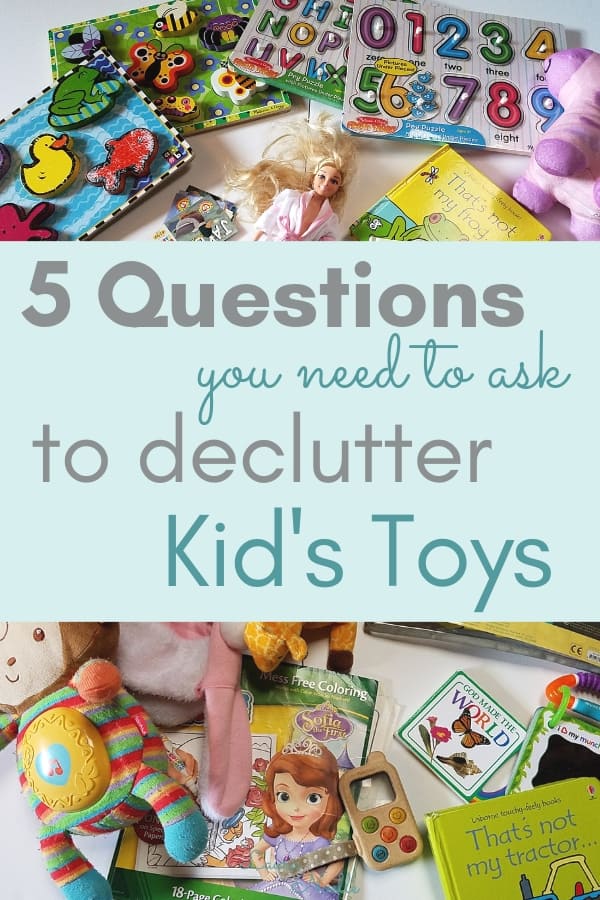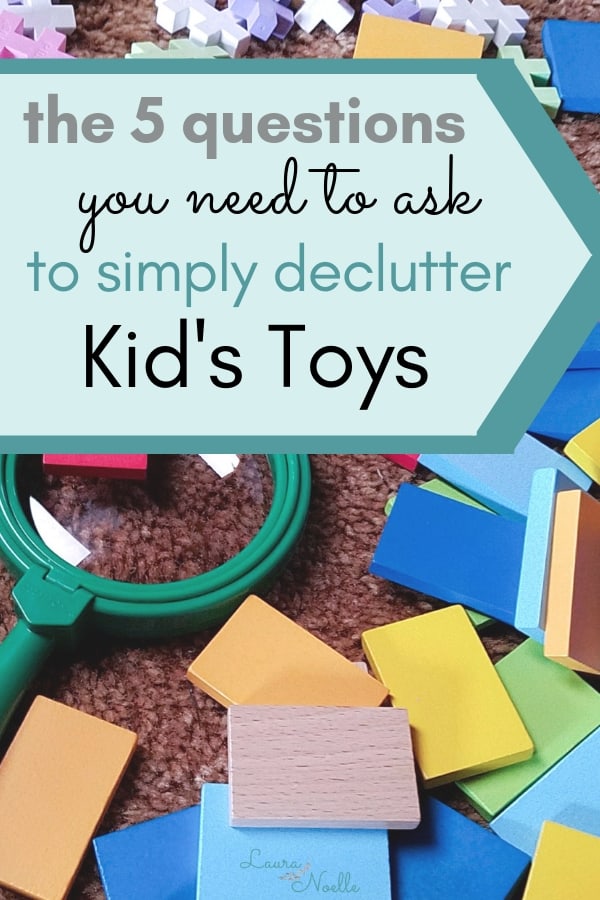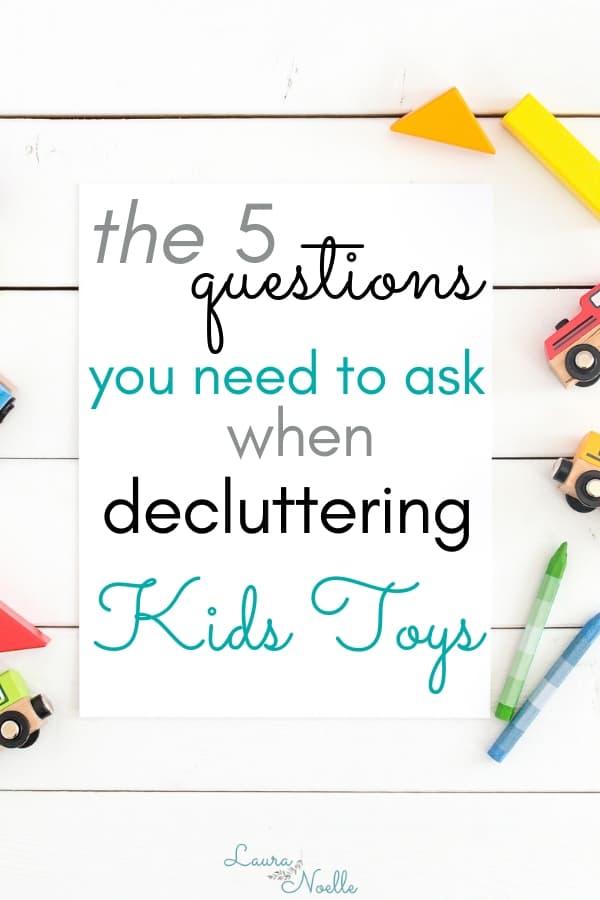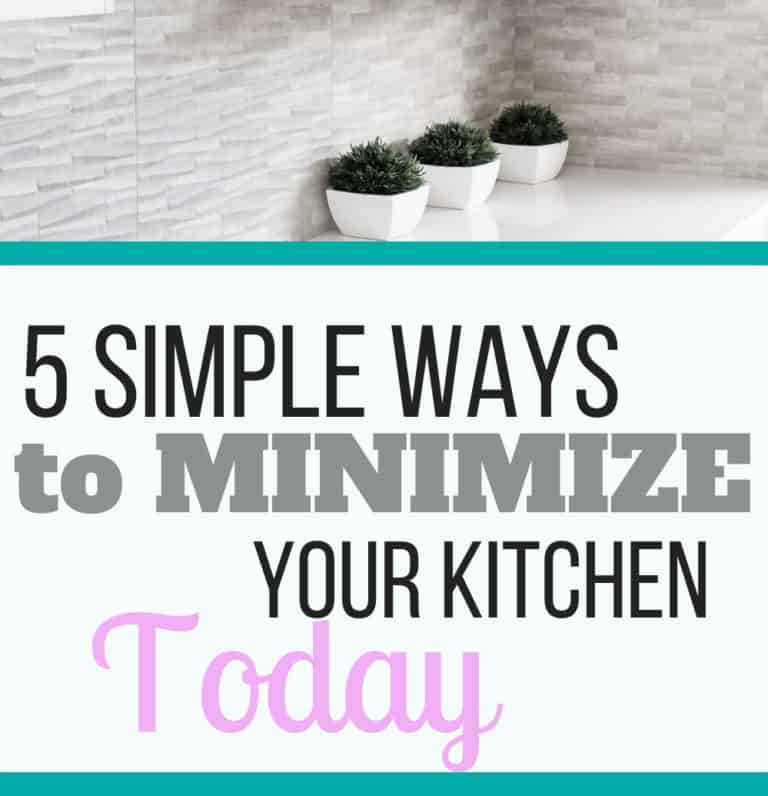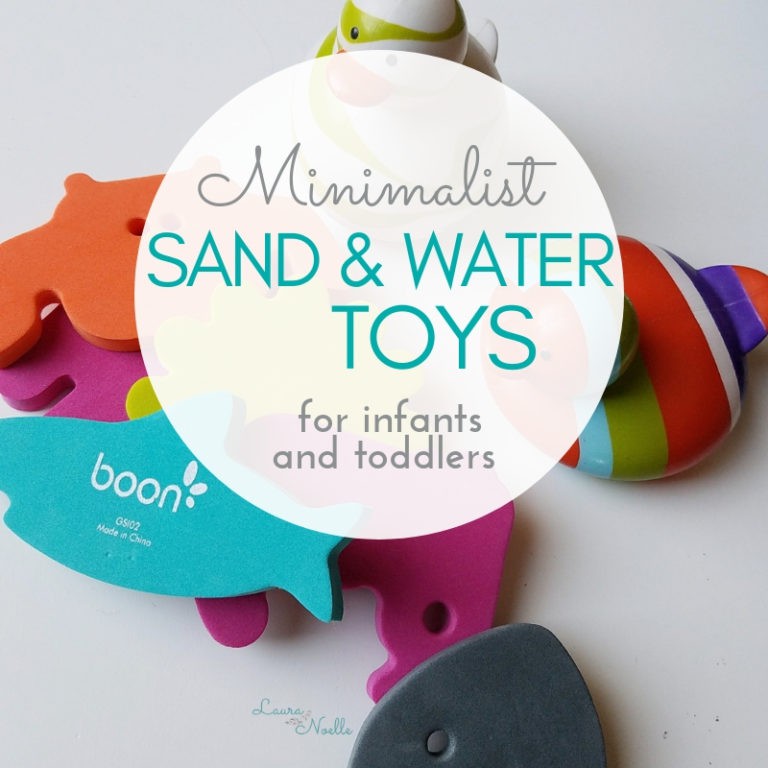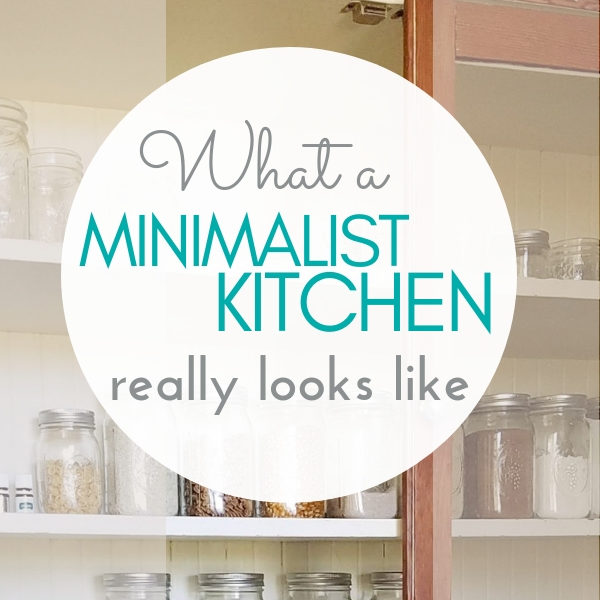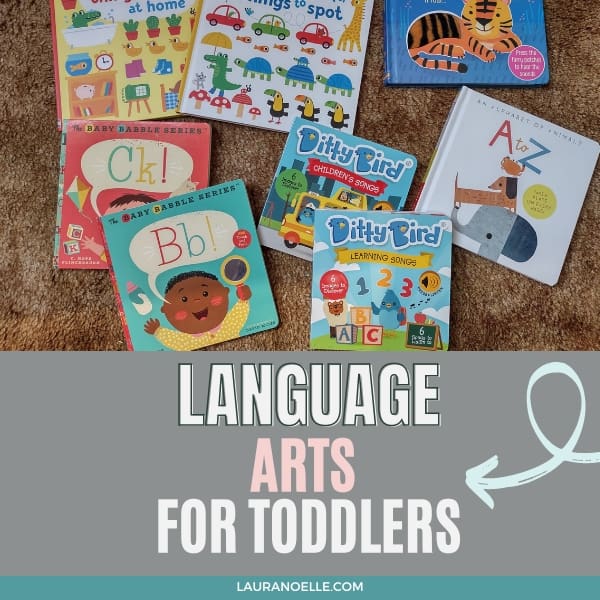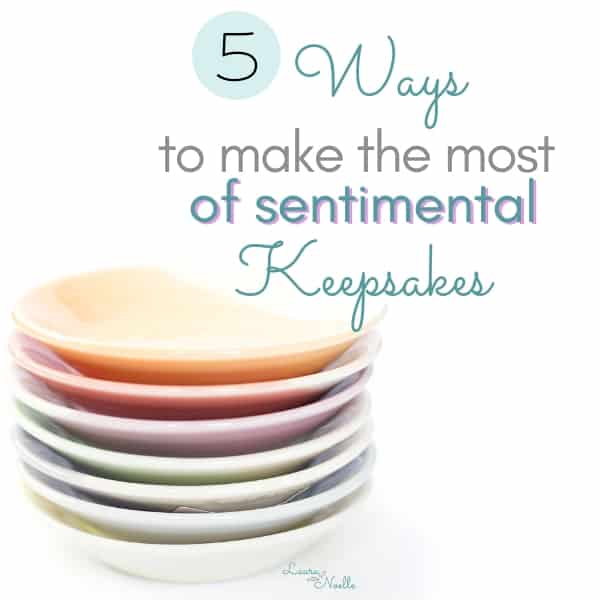The 5 Questions You Need to Ask when Decluttering Kids Toys
This post may contain affiliate links, which means I may receive compensation if you make a purchase using one of these links.
Ready to tackle decluttering the kids toys? Ask yourself these 5 questions and the process will be simple and stress-free!
When you’ve got a house full of toys, it’s easy to feel like you don’t even have the energy to start. Rather than doing it all at once, these 5 questions will walk you through making smart decisions for your family that you won’t regret while you declutter your kid’s toys over time!
Want a free checklist to walk you through it? Grab yours at the bottom of this post!
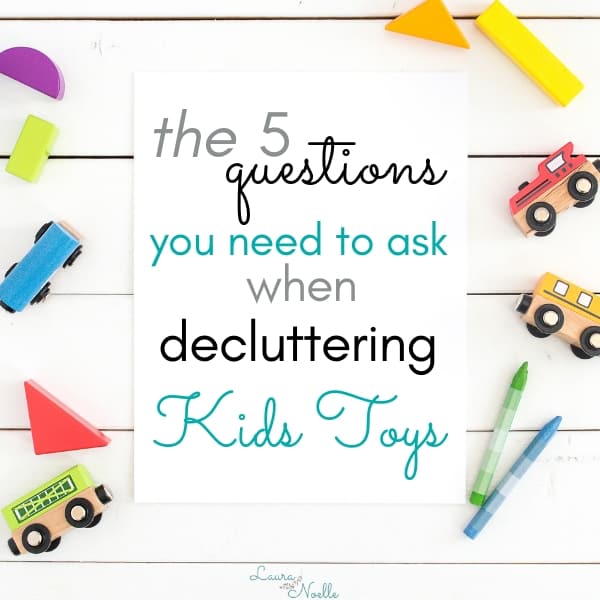
The Simple Way to Declutter Kid’s Toys
No matter how many children you have, the toy clutter can really add up. It’s amazing how even one child can spread her toys from one end of the house to the other–and refuse to pick them up. Been there, Mama, been there.
The most effective way I’ve found to declutter the toys is taking it slow and simple. Instead of standing in the middle of the giant mess in a puddle of tears (also been there), take one small space. A bin, corner, shelf, or pile on the floor. One space at a time.
Then I pick up toys, one at a time, and ask myself a series of questions. While this sounds like it will take a long time, it usually doesn’t because you’ll gain your momentum as you get going. You’ll know what questions to ask and which ones to skip as you get familiar with the types of toys you’re going through.
I recommend grabbing a trash bag and a donation box and keeping them close by as you declutter.
Should My Child Help?
If your child is under 3 years old, you’re the decision maker about what goes and what stays. If they are older than 3, use your judgment to decide how actively they should participate. Some children do very well with letting go of their things, and others struggle.
It may be helpful to include them in small portions of the process to slowly get them accustomed to it, but you know your child’s limits and what they can handle. You may want to do an initial assessment to sort out trash and broken items and bring in your child for the decision process on toys they actually use and value.
Let’s get started! Pick up that first item and ask:
Question 1: What is this item’s value?
The first question is purely practical. The item you picked up might be a beloved toy or it might be a scribbled on piece of paper. It could be a broken toy or something your child dug out of the trash (or is that only my child?!).
Don’t overthink this, instead, quickly answer the question.
- It has no value = junk, trash, broken, not suitable to play with or donate
- Some value = may have been played with in the past but is now outgrown, occasionally played with, forgotten gifts, closed-ended toys
- High value = prized possessions, keepsakes, the most beloved and played with toys
When you identify a toy’s value, place it into the appropriate pile. Trash should be immediately discarded, but the some value and high-value toys will be further sorted later.
Question 2: Who plays with this toy?
If a toy has some or high value to your family, think about who plays with the toy, when they play with it and how often that occurs. This will help you to identify if the toy is created for a particular age level or developmental stage. Most children outgrow and leave behind toys as they grow, but not all do.
- Is it a toy that just one child plays with?
- Is it a toy that encourages play between siblings or friends?
- Is it a toy that enhances positive behavior in your child? (In contrast to toys that bring out negative behaviors like tantrums, defiance, moodiness or poor emotional control)
If a toy is not played with on a regular basis, there are more questions to ask to see if this toy is really benefiting your family. Take note that not all toys that are played with regularly should be kept. There are a lot of factors to consider when minimizing toys!
Question 3: Does this toy inspire open-ended play or creativity?
Probably the most important question you can ask is what does this toy do, or inspire my child to do? Closed toys are those that only function one way. Push a button and the same thing happens every single time. Most toys that are electronic or labeled “educational” fit this category.
However, that’s not to say that closed toys don’t have a place in the home. A small number of them can have a valuable place. An example of this would be puzzles–there is only one way to complete them–but, they do enhance thinking and reasoning skills which are important.
The idea here is to ensure that the majority of toys in the home are open-ended and inspiring creative and imaginative play. Most would agree that character outfits and toys limit a child’s ability to pretend to be anything, but having a few items that are character based won’t ruin your child.
When given the choice I typically choose toys that provide a broad and blank canvas, but I also allow my daughter to have a few items from her favorite characters. It’s all about balance!
Popular categories of toys that are open-ended include:
- wooden blocks, magnetic blocks, and basic building sets
- animal figurines
- gross motor equipment (peanut ball, bilibo, skipping rocks, ribbon dancer)
- creative art supplies
- musical instruments
- basic dress up clothes, dolls, and accessories
Question 4: Is this toy a prized possession or treasure?
As children grow, they sometimes gain interests that puzzle us as parents. The items that my daughter treasures makes me shake my head, but that’s a part of her growth and discovery of the world.
Children should be given some freedom to collect and maintain their beloved possessions and treasures. That being said, they do need your parental guidance to do so.
That rock collection should not be all over the living room floor and the bedroom is not an appropriate place for a rolly-polly collection. That may or may not have been told to me as a child…
To manage decluttering prized treasures, be sensitive but firm with your child.
Set Boundaries
Give your child one drawer, shelf, or bin to house her collection. Be firm that only what fits in that defined space can stay.
Instruct on One-in-One-out
Help your child learn decluttering maintenance techniques like letting go of one old item when they bring a new item in. By doing this, the space won’t end up overcrowded or overflowing.
Teach Responsibility
It’s vital to teach children to take care of their possessions. When they decide the items they want to keep, they take on the ownership. With ownership comes responsibility and they need to understand that their new job is to respect the family by keeping those items cleaned up and put away in their proper place when not being played with.
Question 5: Is this toy benefiting our family or burdening us?
The final question is the hardest, but also the one that gives a final push on what stays and what goes. As I make decisions on my daughter’s toys, I take into account the toy’s value, how often she plays with it, if it’s open-ended and how she feels about it. But at the end, I ask myself if it’s really a toy that I want her to have.
Does it encourage positive behavior? Does it inspire her imagination? Does it support the values that I want for our family (simpler, holistic, slower living)? If yes, then great, that toy stays. If no…I seriously consider what our home would be like if I kept the toy, and if I didn’t.
I’ve used these questions to let go of most electronic toys. The noise alone is a burden to our family and I feel like at her age, toys like that have very little value. But those aren’t the only toys that can burden a family.
I’ll be honest, a few months ago I took away a tin container and a stick that she used to beat on as a drum. I was conflicted on making that decision because she was playing with them in a creative and open-ended way. However, I was getting headaches and losing my patience. For the sake of the family, the drum set was put away.
Benefit versus burden will be unique to your family. It’s okay to put something away in storage for awhile and see how your child does without it. Don’t be afraid to experiment!
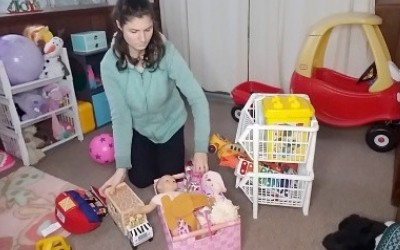
Making Decluttering Decisions
Now you’re ready to make decisions about what should stay and what should go.
1. Discard trash, broken toys and unusable items.
2. Clarify boundary spaces for the toys you want to keep.
Do you have a playroom, shelf, toy box or child’s room where the toys in the home will be stored? Get very clear on where the boundaries will be. If all the toys will be stored in the playroom, or in a toy box in the family room, make sure that everyone is aware of that rule.
Knowing a defined space gives you a blank canvas. Take all the toys out if they aren’t already, ask yourself the 5 questions above about each toy and based on your answers, decide if that toy has earned a spot in your toy space, or if it needs to find a new home.
Remember, only the toys that fit in your defined space get to stay out. This is your defining rule.
Some families find it helpful to set a numerical limit on toys per child. That may be 20 toys per child or 50. Or you may prefer to not think about numbers and stick to the visually defined space above. Neither is right or wrong–do what works for your family.
3. Organize toys you choose to keep by type.
Use shelves, bins, or boxes (preferably shallow or clear) to organize and store toys that are alike. You may have a block bin, animal figurine basket, or stuffed animal drawer. Labeling bins with a picture or word can also be helpful for growing children so they know where to put toys back.
Sample categories include: creative play, dolls & accessories, kitchen supplies, puzzles, cars, legos, etc.
If you’re struggling with making decisions about children’s books, you can learn more pro tips here on sorting and letting go.
4. Make decisions about your some-value and high-value items.
Here’s the tough part. Picking what to declutter. I would recommend thinking about a target number, or spacial area, that you have designated for high-value, and some-value toys. You may want to set a standard like 80% of the toy area can be high-value toys and 20% can be some-value.
Older children will likely have more opinions here, but if there is a lot of push-back, consider setting up toy storage and rotation.
Focus on helping children let go of outgrown, forgotten or neglected toys first, before making decisions on the ones they are more attached to. It is highly recommended to pack away toys they aren’t sure about for a few weeks before donating, just to be sure you aren’t accidentally letting go of a favorite.
Encouraging kids to donate toys to local charities, church nurseries, or preschools starts to plant a seed of generosity and self-sacrifice. Those are two qualities we don’t see a lot in today’s materialistic culture.
Final thoughts on Decluttering Kids Toys
When it comes to decluttering your kid’s toys, asking these 5 questions can make all the difference. Instead of feeling overwhelmed, you’ll feel empowered, confident that you’re making a good decision regardless of if you choose to keep or let go of the toy. Be empowered–you’ve got this!
What kind of toys do you find the most challenging to declutter?
Grab the Free Checklist: 5 Questions to Ask when Decluttering Kids Toys
Subscribe (it’s free!) to my newsletter with updates & tips and get instant access to the resource library with all my printables and challenges! Once subscribed, I’ll send you a weekly newsletter with more tips to help you declutter your home and slow down family life in a heart-centered way!
Related Articles on Minimalism with Kids
WANT TO SAVE The 5 Questions You Need to Ask when Decluttering Kids’ Toys FOR LATER? PIN TO YOUR FAVORITE PINTEREST BOARD HERE:
